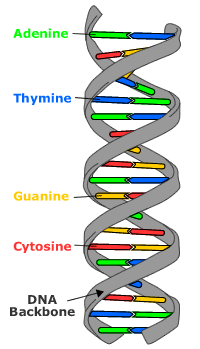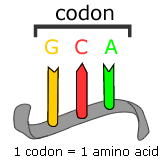 Your DNA contains a set of instructions for building a human. These instructions are inscribed in the structure of the DNA molecule through a genetic code. It works like this:
Your DNA contains a set of instructions for building a human. These instructions are inscribed in the structure of the DNA molecule through a genetic code. It works like this:
DNA is made of a long sequence of smaller units strung together. There are four basic types of unit: A, T, G, and C. These letters represents the type of base each unit carries: adenine, thymine, guanine, and cytosine.
The sequence of these bases encodes instructions. Some parts of your DNA are control centers for turning genes on and off, some parts have no function, and some parts have a function that we don’t understand yet. Other parts of your DNA are genes that carry the instructions for making proteins — which are long chains of amino acids. These proteins help build an organism.
 Protein-coding DNA can be divided into codons — sets of three bases that specify an amino acid or signal the end of the protein. Codons are identified by the bases that make them up — in the example at right, GCA, for guanine, cytosine, and adenine. The cellular machinery uses these instructions to assemble a string of corresponding amino acids (one amino acid for each three bases). The amino acid that corresponds to “GCA” is called alanine; there are twenty different amino acids synthesized this way in humans. “Stop” codons signify the end of the newly built protein.
Protein-coding DNA can be divided into codons — sets of three bases that specify an amino acid or signal the end of the protein. Codons are identified by the bases that make them up — in the example at right, GCA, for guanine, cytosine, and adenine. The cellular machinery uses these instructions to assemble a string of corresponding amino acids (one amino acid for each three bases). The amino acid that corresponds to “GCA” is called alanine; there are twenty different amino acids synthesized this way in humans. “Stop” codons signify the end of the newly built protein.
The completed protein is then released to do its job in the cell.
